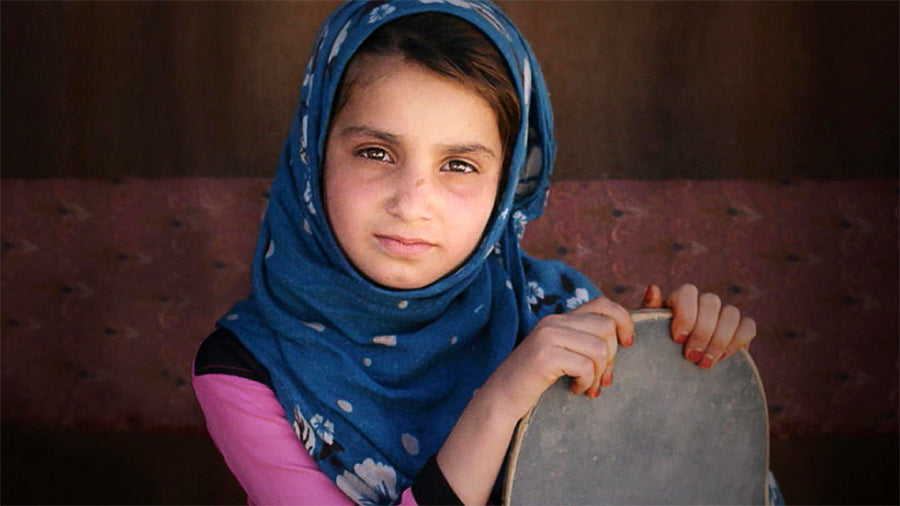





Holiday Gift Guide - Clothing & Gear Up to 75% Off! SHOP NOW
![An Afghan girl jumps on her skateboard in Kabul on June 21, 2012; hundreds of Afghan boys and girls celebrated World Skateboarding Day in the national capital [File: Ahmad Jamshid/AP] An Afghan girl jumps on her skateboard in Kabul on June 21, 2012; hundreds of Afghan boys and girls celebrated World Skateboarding Day in the national capital [File: Ahmad Jamshid/AP]](https://cdn.shopify.com/s/files/1/1299/2659/files/skate-header.jpg?v=1583820800)
Last month the film Learning to Skateboard in a Warzone (if you're a girl) won the Oscar for best documentary (short subject). The film focuses on Afghan girls who learn to skate through a programme run by Berlin-based NGO Skateistan which purports to "give children the opportunity to become leaders for a better world" by combining "skateboarding with creative, arts-based education".
At the Oscars ceremony, director Carol Dysinger described the film as a "love letter to the brave girls of that country" and praised the work of Skateistan, which, in her words, teaches "girls courage, to raise your hand, to say I am here and I have something to say".
With this win, Learning to Skateboard in a Warzone joins a long list of Western-produced, critically acclaimed films, books, articles, photos, etc about Afghan women and girls in distress who - often with the helpful hand of a Westerner - find their way to empowerment.
In recent years, we saw Barry Levinson's Rock the Kasbah (2015), in which a young Afghan singer (played by Palestinian actress Leem Lubany) is "discovered" by a struggling American music manager (Bill Murry). There was also Angelina Jolie's animated feature Breadwinner (2017) about a girl who disguises herself as a boy to support her struggling family during the Taliban rule in Kabul.

The film is based on the award-winning trilogy of books The Breadwinner (2001-03) by Canadian author Deborah Ellis who got inspired to write them after interviewing Afghan refugees in a camp in Pakistan in the late 1990s.
Articles about "Afghan girl empowerment" also regularly make it to Western media outlets. There have been a myriad of stories about "Afghanistan's first female graffiti artist who is risking it all for her murals"; about Afghan girls learning to play Coldplay and Bob Marley songs on a guitar; about an all-female orchestra telling the Taliban "we won't be silenced" and so on.
In all of these stories, Afghan women and girls who pursue their interests are presented as seemingly breaking the gender norms of their society. They are artists, hipsters, rebels with a cause, who are often introduced as trailblazers, the first-of-whatever social experience that is "unheard of" in their natural landscape of violence, poverty and misfortune.
So why does the West love to tell stories of Muslim girls doing edgy or artsy things in Afghanistan? Why do these stories matter so much to Western audiences?
These stories decontextualise the lives of these girls, presenting them as ideal victims for pity and ideal heroes for admiration. Their feats make Westerners feel good about the war in Afghanistan, that unlike the Iraq war was the "good" war, which "liberated" girls and women and gave them opportunities their own society would have never afforded them. After all, the "liberation of Afghan women" was one of the declared noble causes of the 2001 US-led invasion named Operation Enduring Freedom.
Apart from evoking white saviour emotions, such stories also serve well to cover up the complexities of economic and political realities in Afghanistan and elsewhere in the Muslim world. Indeed, it is much more soothing and gratifying for a Westerner to believe that girls and women suffer because of the "inherent backwardness" of their societies rather than because of centuries of ruthless Western military and political intervention in their countries leading to constant conflicts.
These stories set the scene in Afghanistan and elsewhere as a clash of values - modern vs tradition, women vs patriarchy, individual desire vs community norms - and conveniently drive attention away from the horrors of the global "war on terror" and the havoc it has wreaked on the lives of Afghan women and men.
The experiences of Afghan (and more generally Muslim) girls and women are thus commodified into what media scholar Gillian Whitlock calls propaganda "soft weapons" - narratives from the third world which serve the political and military agenda of Western powers. In this sense, all these stories of empowerment are mediated for the purposes of Western intervention.
One could trace Western obsession with women's and girls' victimhood in Afghanistan to one iconic image - the 1985 National Geographic's Afghan girl cover. For decades, the image of eight-year-old Afghan refugee Sharbat Gula was published, reprinted and displayed many times without her name or true story. It was accompanied by a single deceptive caption "Haunted eyes tell of an Afghan refugee's fears".
Her eyes, however, were not full of fear but rather anger at a white man - American photographer Steve McMurry - who had barged into her all-girls class and made her teacher order her out to pose for a photo she did not want to pose for.
Fifteen years later, Sharbat was dragged out of her village and made to take a nine-hour journey so she would again be forced to show her face to that same white man and his white crew from the National Geographic.
Her body would be objectified and commodified again. "Time and hardship have erased her youth. Her skin looks like leather. The geometry of her jaw has softened. The eyes still glare; that has not softened," declared the magazine.
Sharbat's experience is a perfect illustration of what American writer and filmmaker Susan Sontag's critique of photography: "To photograph people is to violate them, by seeing them as they never see themselves, by having knowledge of them that they can never have; it turns people into objects that can be symbolically possessed."

Countless Afghan girls and women have been possessed in this manner, framed and packaged for Western consumption and enjoyment. Meanwhile, their lives continue to be decontextualised, the real reasons behind their suffering and victimisation - obfuscated.
The West takes violence and toxic patriarchy for granted, accepts them as inevitable, and ignores their roots in conflict. It cannot imagine Afghan (or any other Muslim) society transforming, walking its own way to gender harmony, creating conditions for young women (and men) to pursue their ambitions in a safe and nurturing environment.
"Solutions" are instead seen as a series of social interventions and NGO programmes which provide and encourage "fun activities" - skateboarding, graffiti, music, etc which draw these girls and women closer to the Western image of a "liberated girl or woman" and which supposedly make all the difference in their otherwise static grim reality.
This approach is reminiscent of palliative care which aims to optimise the quality of life for patients at the end of their life. Afghan girls and women are provided with care that manages symptoms of structural problems - conflict, poverty, lack of resources, education, etc - rather than the problems themselves.
This is because their society is perceived as "doomed", stuck in its "backwardness", and dismissed as a vanishing presence in history.
Thus, stories like Learning to Skateboard in a Warzone put hope in individual acts of "bravery" over the possibility of society-wide transformative movements for economic and political justice.
Yet, it is a much braver feat for Afghan girls and women to imagine and fight for true transformative political and societal change in their country that will bring safety, freedom of choice and justice for all, not for a select few.
News Source: www.aljazeera.com
Images Source: allthatsinteresting.com, i.ytimg.com, cropper.watch.aetnd.com, aljazeera.com
The first ten skateboarding tricks you should learn include both flip tricks and grinds...
Among a host of other unusual athletic competitions, skateboarding will make its debut ...
Charles Michael "Bucky" Lasek (/ˈleɪsɪk/ LAY-sik; born December 3, 1972) is a professio...

Wishlist are temporary to this session Only . your product(s) will not be saved permanently.